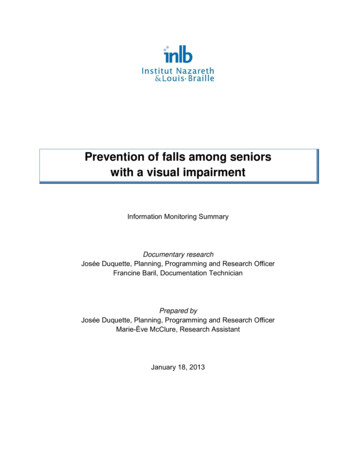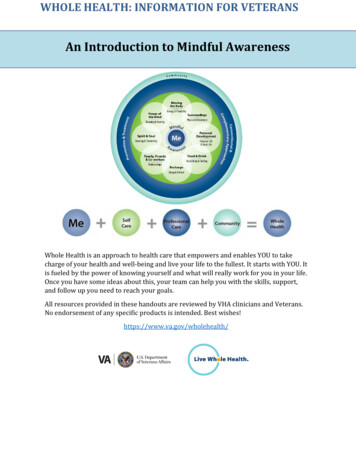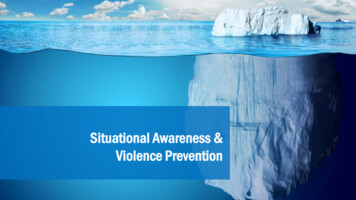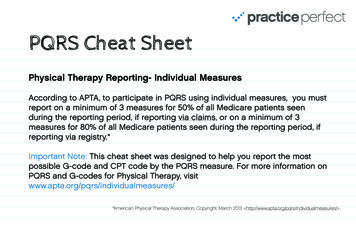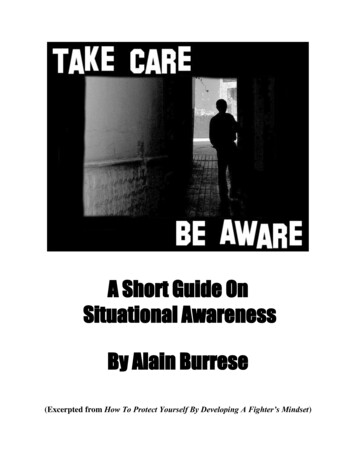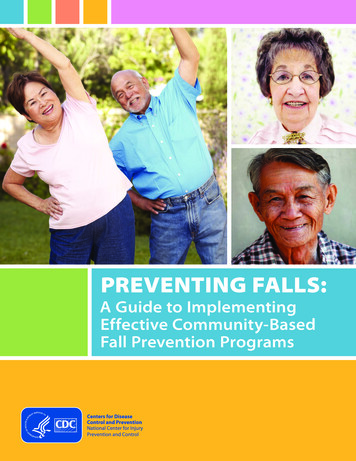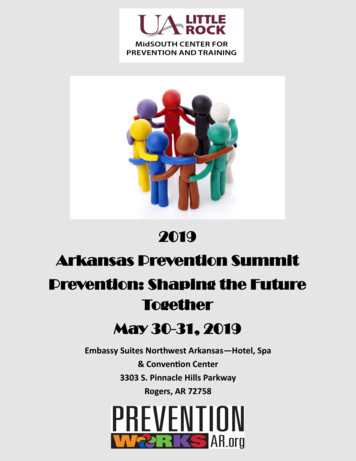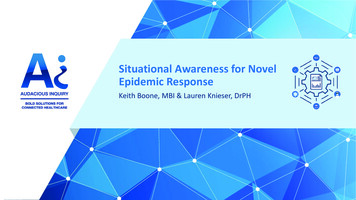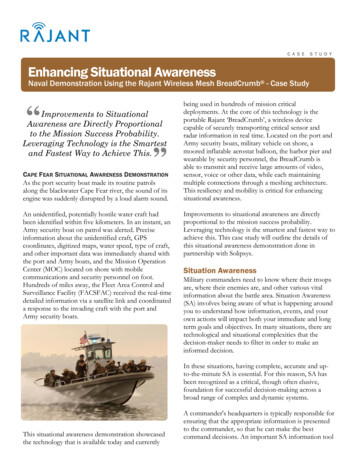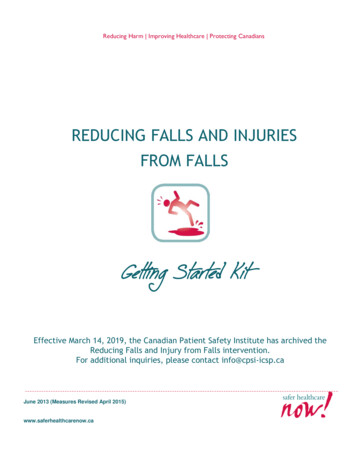
Transcription
HOME SAFETYIS BONE SAFETY.FALLS AWARENESS &PREVENTION GUIDEPrepare your home or assist a loved onetoday by following these fall-proofingrecommendations, courtesy of the AmericanAcademy of Orthopaedic Surgeons and TheOrthopaedic Trauma Association.
FALLS AWARENESS &PREVENTION GUIDETaking a fall at home can be a frightening and life-changing experience, especially forthe elderly and those living alone. But, with a few simple changes at home, you andyour loved ones can protect your bones and stay safe and independent at home.HOME SAFETYIS BONE SAFETY.Don’t overlook the risks lurking in your home or the changes needed to safeguard yourhealth. Take steps today to prevent accidents and injuries. Remember: Home Safety isBone Safety!In this guide, the members of the American Academy of Orthopaedic Surgeons (AAOS)and The Orthopaedic Trauma Association share tips on how you or a loved one can: ecognize the medical, personal and environmental factors that increase your riskRof a fall. Make modifications to your bathroom, stairways, kitchen, bedroom and living areasto help fall-proof your home. Reduce your risk of injury and contact a friend, relative or emergency service in theevent of a fall.According to the Centers for Disease Control and Prevention, falls are the leading causeof both fatal and nonfatal injuries among elderly adults. In 2010, more than 2.3 millionAmericans were treated in emergency departments for fall-related injuries, leading tonearly 30 billion in direct medical costs.The statistics can be grim, but the solutions are simple. Learn more at orthoinfo.org/falls.
ARE YOU AT A HIGH RISKOF A FALL?There are a number of medical, personal and environmental factors that can makesomeone more susceptible to a fall-related injury. Familiarize yourself with the followingrisk factors to find out if you or a loved one is at a high risk of falling.MEDICALRISK FACTORS Impaired musculoskeletal function Osteoporosis Cardiac arrhythmias (irregular heartbeat) Blood pressure fluctuation Alzheimer’s disease and senility Arthritis Hip weakness and imbalance Neurological conditions such as stroke,Parkinson’s disease and multiple sclerosis Urinary and bladder dysfunction Vision or hearing loss Cancer that affects the bones Side effects of medicationsWhat lifestyle choices canyou make to help reduceyour risk of falling?There are a number of things you cando to keep your bones strong andlessen your risk of a fall-related injury,including:HOME SAFETYIS BONE SAFETY.PERSONALRISK FACTORS Inadequate footwear Not drinking enough water Excessive use of alcoholENVIRONMENTALRISK FACTORS Maintain a healthy lifestyle and stayphysically active. Have your bone density testedannually to help recognize signsof developing osteoporosis, asrecommended by your physician. Get an annual eye examination. Get an annual physical thatincludes an evaluation for cardiacand blood pressure problems. Maintain a healthy diet withadequate dietary calcium andVitamin D from both food andsupplements. Check with your doctor(s)about any side effects of yourmedications; make sure allmedications are clearly labeled andstored in a well-lit area and takemedications on schedule with a fullglass of water, unless otherwiseinstructed.BONE LOSSRISK FACTORS Slippery or wet surfaces Poor lighting Cluttered pathways in the home Lack of exercise and activity Pets that create tripping hazards Smoking All throw rugs and area rugs that are notproperly secured Unhealthy dietMore info at orthoinfo.org/falls
TIPS ON FALL-PROOFINGYOUR HOMEResearch shows that simple safety modifications at home, where most falls occur, cansubstantially cut the risk of falls and related injuries — such as bone fractures — for seniors.Prepare your home or assist a loved one today by following these fall-proofing recommendations,courtesy of the American Academy of Orthopaedic Surgeons and The Orthopaedic TraumaAssociation.BATHROOM Place a slip-resistant rug or rubber matadjacent to the bathtub for safe exit andentry. Use a rubber mat or place non-skidadhesive textured strips inside the tub. Install grab bars on the shower walls. Stabilize yourself on the toilet byusing a raised seat or a toilet seat witharmrests. Keep a nightlight on in the bathroom.Replace glass shower enclosures withnon-shattering material.KITCHENHOME SAFETYIS BONE SAFETY. Keep stairs clear of packages, boxes orclutter. Provide enough light to clearly see eachstair and the top and bottom landings.Use a sturdy, plastic seat in the bathtubif you cannot lower yourself to the floorof the tub or you are unsteady. STAIRWAYSRemove all throw rugs and hold arearugs in place with a rubber, slipresistant backing. Use non-skid floor wax. onsider installing motion-detectorClights that turn on automaticallywhen you approach. eep flashlights nearby in case of aKpower outage.Remove all throw rugs, and secure arearugs near the bottom and top of stairswith a rubber, slip-resistant backing. Install a contrast strip on the edge ofeach stair to increase their visibility. Put non-slip treads on each bare-woodstep. Install handrails on both sides of thestairway. E ach should be 30 inches above thestairs and extend the full length ofthe stairs.Store food, dishes and cookingequipment within easy reach. ight switches should be at bothLthe top and bottom of stairs. Immediately clean up any liquids,grease or food spilled on the floor. D o not stand on chairs or boxes toreach upper cabinets. Repair loose stairway carpeting,wooden boards and loose handrailsimmediately.More info at orthoinfo.org/falls
TIPS ON FALL-PROOFINGYOUR HOME continuedBEDROOM Place a lamp, telephone and flashlightnear your bed. Keep clutter off the bedroom floor.Arrange clothes in your closet so thatthey are easy to reach. Do not stand on chairs or boxes toreach upper shelves. Install a nightlight along the routebetween your bedroom and thebathroom. Sleep on a bed that is easy to get intoand out of. Replace satiny sheets and comforterswith non-slip fabrics such as flannel.LIVING AREAS Arrange furniture so that you have aclear pathway between rooms. Keep the path between your drivewayand the front door, as well as thepathway between the mailbox and yourfront door well-lit and clear of debris. For cold weather locations, keep saltand a shovel near the front door so youdo not have to walk on an icy sidewalkin order to reach them.HOME SAFETYIS BONE SAFETY. Install motion-detector lights so theyturn on automatically when you stepoutside at night. Motion or sound activated lights andglow-in-the-dark switches are alsohelpful. Remove boxes, newspapers andall clutter from pathways, includingdoorways and hallways. Keep electric, appliance andtelephone cords out of walkways,but do not hide cords under a rugbecause it creates a tripping hazard. Secure loose area rugs with a rubber,slip-resistant backing. Replace chairs or sofas that are so lowthey are difficult to get out of. Repair loose wooden floorboardsimmediately. Remove door sills higher than a half inch.At least one covered, no-step entry witha ramp is recommended for any home.FOOTWEARWalk only in well-lit rooms and alwaysturn on lights. Install easy-access light switches atroom entrances so you do not haveto walk into a dark room to turn onthe light.OUTSIDE Keep low-rise coffee tables, magazineracks, footrests and plants out of thepath of foot traffic.PETS Place a bell on your small pets so youcan locate them easily and know whenthey are near your feet, creating apotential tripping hazard. Wear properly fitting shoes with rubber,non-skid soles. Avoid wearing high heels. Tie your shoe laces and never walk inbare socks.Train dogs to walk beside you, insteadof in front of you. Replace slippers that have stretched outof shape or are too loose.In the case of a larger or stronger dog,train your pet not to pull you when on aleash.More info at orthoinfo.org/falls
WHAT YOU NEED TO KNOWIF YOU FALLTaking a fall at home can be very frightening, especially if you are home alone or havebeen injured as a result. Follow these guidelines and share them with family members tohelp you or your loved ones recover quickly from a fall:BEFOREYOU FALL Make the changes suggested in the homesafety checklist. Make it a habit to have a relative, friendor neighbor check in with you once aday so there is someone designated toinvestigate in case you are unable toanswer the phone or come to the door.WHENFALLING Do not extend your arms to break thefall. Instead, raise an arm to protect yourhead. Try to fall on your side or buttocks and rollover naturally.AFTERYOU FALL HOME SAFETYIS BONE SAFETY.Ensure your safety: Medical alert devices area helpful way to help ensure your safety afteran unfortunate fall or accident. In order for a medical alert device to beeffective, it must be worn at all times,even when showering or sleeping. Do not panic! If you try to get up too earlyor from the wrong position you couldmake an injury worse. Cellphones are not an effective alternativeto medical alert devices. They are notwaterproof and do not remain attachedto your body when undressed. Also,someone with mild cognitive impairmentmay not be able to use a phone properly,especially in a time of panic and distress. Take several deep breathes, assess thesituation and determine if you are hurt. If possible, slide or crawl along the floorto the nearest couch or chair and try toget up. If you are badly injured, do not try to getup. Instead, call for help from a familymember or close neighbor. If you are alone, crawl slowly to thetelephone and call a relative, friend or911.More info at orthoinfo.org/falls
and blood pressure problems. Maintainahealthydietwith adequate dietary calcium and Vitamin D from both food and supplements. Check with your doctor(s) about any side effects of your medications; make sure all medications are clearly labeled and stored in a w
